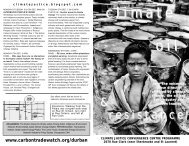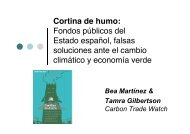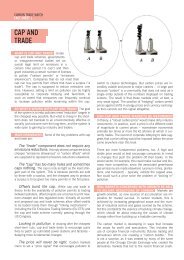The Sky is Not the Limit: - Carbon Trade Watch
The Sky is Not the Limit: - Carbon Trade Watch
The Sky is Not the Limit: - Carbon Trade Watch
- No tags were found...
You also want an ePaper? Increase the reach of your titles
YUMPU automatically turns print PDFs into web optimized ePapers that Google loves.
3. Trading Rules3.1 <strong>The</strong> Kyoto Trading RegimeWhile Kyoto <strong>is</strong> just one of <strong>the</strong> carbontrading regimes under development, it<strong>is</strong> <strong>the</strong> most advanced. It <strong>is</strong> also <strong>the</strong>platform that legitim<strong>is</strong>es <strong>the</strong> growth ofo<strong>the</strong>r trading schemes. For example,<strong>the</strong> em<strong>is</strong>sion targets in <strong>the</strong> KyotoProtocol create <strong>the</strong> scarcity inem<strong>is</strong>sions that make a competitivemarket possible. <strong>The</strong> Kyoto tradingregime <strong>is</strong> a combined cap-and-tradeand cap-and-credit system. <strong>The</strong> capand-tradesystem <strong>is</strong> formed by settinga fixed quantity of permits (<strong>the</strong> cap),d<strong>is</strong>tributing <strong>the</strong>m and allowing <strong>the</strong>m tobe traded. <strong>The</strong> cap-and-trade system<strong>is</strong> included in <strong>the</strong> Kyoto FlexibleMechan<strong>is</strong>m “Em<strong>is</strong>sions Trading”. Eachcountry that committed to a Kyotoreduction target has a quota ofpermits. <strong>The</strong> size of that quota comesfrom each country’s 1990 em<strong>is</strong>sionslevel minus <strong>the</strong> amount <strong>the</strong>y havecommitted to reduce.<strong>The</strong> credit-and-trade system <strong>is</strong> formedby allowing em<strong>is</strong>sion-reducing projectsto generate permits equivalent to <strong>the</strong>amount of em<strong>is</strong>sions <strong>the</strong>y save. <strong>The</strong>project based credit-and-tradesystems in <strong>the</strong> Kyoto Protocol are <strong>the</strong>Clean Development Mechan<strong>is</strong>m andJoint Implementation. Using Kyotogreenhouse gas em<strong>is</strong>sions permits <strong>is</strong>much like using money in manyrespects. You can bank most permitsfor future use or sell <strong>the</strong>m if you havean excess. If you run out of permitsyou can buy or borrow more.Governments trading improperly willgo to a court-like forum and couldeven be excluded from trading. If <strong>the</strong>ybelieve <strong>the</strong>y have been treatedunfairly, <strong>the</strong>y also have <strong>the</strong> right toappeal. 1Money-like character<strong>is</strong>tics come from<strong>the</strong> rules set out in <strong>the</strong> Kyoto Protocol.An example <strong>is</strong> <strong>the</strong> interest rate forborrowing by governments, whichcomes from <strong>the</strong> penalty for overemittingin one em<strong>is</strong>sions budgetperiod. <strong>The</strong> technical name for <strong>the</strong>em<strong>is</strong>sions budget period <strong>is</strong> <strong>the</strong>‘compliance period’, <strong>the</strong> first of which<strong>is</strong> 2008-2012. If at <strong>the</strong> end of 2012,you are m<strong>is</strong>sing 100 permits to makeyour em<strong>is</strong>sions-budget balance, <strong>the</strong>nfor next compliance period you mustfind an extra 130 permits. That <strong>is</strong>, youpay an amount of 0.3 permits for everyton of greenhouse gas you fail toreduce. <strong>The</strong> interest rate of 30 percent for a five-year compliance periodtranslates into approximately a 5 percent yearly interest rate.If you are a corporation, you tradewithin leg<strong>is</strong>lation defined by <strong>the</strong>government of <strong>the</strong> country you areactive in. It <strong>is</strong> however easy to form asubsidiary company, or if you are atransnational corporation to useinternal trading and take advantage ofbeneficial trading rules in <strong>the</strong> countryof your choice. <strong>The</strong>re <strong>is</strong> no cap ontrading to promote domesticreductions at source and it <strong>is</strong> unclearhow governments could stop youtrading if <strong>the</strong>y are in danger ofexceeding <strong>the</strong>ir em<strong>is</strong>sions target. Ifyou are a multinational company youcan trade internally between differentnational arms of your corporation,taking advantage of schemes togenerate cheap permits in <strong>the</strong>developing world.Combing through <strong>the</strong> myriad rulesgoverning th<strong>is</strong> new system, <strong>the</strong> Kyotopermits can seem to be taking shapeas a credible new commodity.However, by compar<strong>is</strong>on withcenturies of international trade, <strong>the</strong>Kyoto commodity <strong>is</strong> young andmalleable. Rules attempting to protect<strong>the</strong> commodity’s environmentalintegrity are fragile. It <strong>is</strong> questionablewhe<strong>the</strong>r <strong>the</strong>se rules are robust enoughto survive <strong>the</strong> pressures ofinternational trade.20











